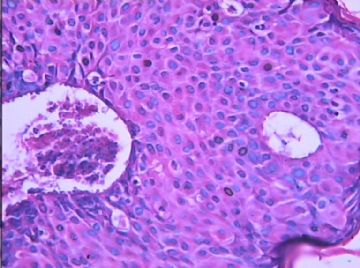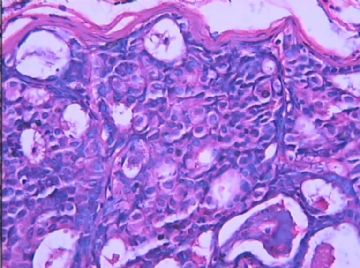| 图片: | |
|---|---|
| 名称: | |
| 描述: | |
- B1572乳腺低级别导管内癌?
| 姓 名: | ××× | 性别: | 女 | 年龄: | 36岁 |
| 标本名称: | 左侧乳腺包块 | ||||
| 简要病史: | |||||
| 肉眼检查: | |||||
相关帖子
- • 左乳腺肿物
- • 乳腺癌?
- • 乳腺肿物
- • 乳腺肿物
- • 左乳癌标本乳头一个导管内的病变
- • 乳腺两个相邻导管内的病变
- • 乳腺肿物,请各位老师帮忙会诊
- • 女 46岁发现左乳腺肿块一月余
- • 乳腺肿物
- • 乳腺肿物
-
n03553522119 离线
- 帖子:1643
- 粉蓝豆:40
- 经验:1879
- 注册时间:2014-11-07
- 加关注 | 发消息
-
本帖最后由 于 2008-12-08 12:30:00 编辑
“You are expert now. Ha ha”惹cqzhao老师笑话了是吧,没关系,专家是什么我不懂,因为我只是一个不喑世事的普通病理医生。您说的很对,作为病理医生,最主要的目的是确保我们诊断的准确性,肿瘤的治疗与我们无关,我不知道如果您遇到这种级别的导管内癌被切除了乳房,且还要被临床医生继续追加化疗的时候,你的心情是怎么样的?反正我的心里很难过!我为这个病人从此缺失一侧乳房而找不回应有的自尊而难过!(因为原本这个乳房是可以保留的)我为所谓的肿瘤医生还要继续给她追加化疗而难过!(因为众所周知,接受化疗的病人是很痛苦的,而这个病人需要接受进一步的化疗吗?如果她是您的亲人,您会让她接受化疗吗?)因此当这个病人家属来拿报告的时候,我就斗胆的告诉他不需要再化疗了。最后谢谢您的提醒,我和我们医院的肿瘤科医生相处的很好,我不敢说他们都很敬重我(包括我说的那为专家),但是我敢说他们都比较认可我。
-
onepiecex: 说的很棒,我妈妈感觉是这个状态,作为病人的家属听到医生建议要全部切除时的心情是无法言喻的,但又没有根据能质疑医生的决定。2014-12-28 07:32
-
stevenshen 离线
- 帖子:343
- 粉蓝豆:2
- 经验:343
- 注册时间:2008-06-03
- 加关注 | 发消息
| 以下是引用byq在2008-12-4 6:44:00的发言: 谢谢abn的翻译!谢谢stevenshen老师的解答!作为病理医生,今后遇到类似这种导管内癌的病人,又没有很明确的乳腺癌家族史的情况下,是否可以向临床医生和病人家属建议选择保乳手术?(注:说句实在的,你们可能不相信,因为我们是一家县级市综合型医院,医院里唯一的一个所谓肿瘤专家,连HER-2是什么都不知道,我真服了他。) |
-
stevenshen 离线
- 帖子:343
- 粉蓝豆:2
- 经验:343
- 注册时间:2008-06-03
- 加关注 | 发消息
- If there is no invasive cancer, definitely NO chemotherapy. I believe that the oncologists should have access NCCN quideline with Chinese translation.
- If clearly DCIS, unilateral mastectomy can be an option.
- If clearly LCIS, bilateral mastectomy remains acceptable choice, particularly for patients with family history of breast cancer or other high risk factors
- For both DCIS and LCIS, the current practice seems to recommend more conservative therapy (for LCIS observation or hormonal therapy, DCIS - lumpectomy with radiation or hormonal therapy based on ER/PR)
- Please consult knowledgeable breast oncologist.
| 以下是引用byq在2008-12-3 3:12:00的发言: 谢谢楼上各位老师的指导!这是外院送到我院做IHC的蜡块切片,原单位报告是:多灶性的小叶原位癌,听病人家属说医生已经将病人的乳房切掉,并已入住肿瘤科准备下一轮的化疗方案。我看了HE切片以后,感觉诊断有些欠妥,所以传上来请教各位老师。另外我想请各位老师讨论一下象这种情况该不该切乳房,以及需不需要下一轮的化疗。我没有批评那家医院的意思,我只想通过认为这个病例,明确当我们面对这种情况的时候,作为病理医生我们应该给临床医生和病人家属一个什么样的合理化建议,仅此而已。恳请各位老师继续给予指导。谢谢了! |
-
本帖最后由 于 2008-12-03 22:20:00 编辑
Continue my writing:
3. Silverstein et al. Prognostic classification of breast of ductal carcinoma in situ. Cancer 1995:345:1154-1157. Silverstein proposed a classification of DCIS based on nuclear grade(high or nohigh) and the presence or absence of necrosis as part of a prognostic index.
No single grading system for intraductal carcinoma has been demonstrated to notably superior, and none has gained widespread acceptance. However, a pathology report for DCIS should provide information about the descriptive characteristics considered to be essential in most grading system. The three essential elements noted were nuclear grade, necrosis, and architectural pattern. So for DCIS, we just report nuclear grade , architectural (or growth) patterns (solid, cribriform, et al), necrosis and microcalcification if they are present. It is easy to call nucear grade 1 and 3 immediately. It is nuclear 2 if you are thinking what it will be. We report Nottingham grade for invasive carcinoma.
In term of your question, the grad should be increased if necrosis is present. I did not see the study report s about this and cannot evaluate it. It is not unusual to see UDH with central necrosis. I just wonder it can be called ADH. I do not think so.
I think the most importance for pathologists is that we and surgens or oncologists use the same lanuages. We should be consistent in our pathology reports. They know what we are talking about.
Thank you. I have to read some book and papers for your interesting question.
Hope some one can translate into Chinese.
abin译:
接上:
3. Silverstein(Silverstein et al. Prognostic classification of breast of ductal carcinoma in situ. Cancer 1995:345:1154-1157)根据核级别(高或非高级别)和是否存在坏死作为预后指数。
没有哪一个导管内癌的分级系统被证明具有明显的优越性,也没有任何一个得到广泛接收。然而,DCIS的病理报告中应当提供足够信息,包括大多数分级系统中认为重要的描述性特征。三个重要方面包括核级别、坏死和结构类型。因此,对于DCIS,我们只报告核级别、结构或生长模式(实性、筛状等)、坏死和微钙化如果存在也要报。核级别1和3很容易取,只是核级别2很费思考。我们用Nottingham分级报告浸润性癌。
对于你提到的,如果坏死存在,分级就上升。我没有见过这方面的研究报告,不好评价。UDH伴中央坏死也并不少见。我只会考虑它是否可能为ADH。我不这样认为。
我认为对病理学家最重要的是,我们和外科医生和肿瘤学家使用相同语言。我们应当在病理报告中一致起来。他们知道我们在讲什么。
谢谢你。你的问题,我要看书查资料才能回答。
-
本帖最后由 于 2008-12-03 21:54:00 编辑
From 笃行者
诚然,坏死并不能鉴别UDH、ADH、DCIS.但认为在DCIS的分级中有意义。
我们所掌握的标准是:DCIS 核1级时---低级别DCIS
核2级时---中间级别DCIS
核3级时---高级别DCIS
但是,如果低级别(1级)的核,加上有粉刺样坏死,则诊断中级别DCIS
中间级别(2级)的核,加上粉刺样坏死,则诊断高级别DCIS
不知当否,请指教。
Thank Dr. 笃行者 for reading my comment. Sorry I even do not know how to call the first letter of your chosen name. My Chinese teacher did not teach me well. Ha, Ha.
There are many different classification of DCIS. I list few examples here
1. Scott (modified Lagios system)(Scott MA et al. Ductal carcinoma in situ of the breast: reproducibility of histological subtype analysis. Hum Pathol. 1997;28(8):967-973)
A. Low grade: Noncomedo histology, low nuclear grade and no necrosis.
B. Intermediate grade: Intermediate histology, intermediate nuclear grade and no necrosis.
C. High grade: Comedo histology, high nuclear grade and extensive necrosis.
2. European Pathologists Working Group: (Holland R. et al. Ductal carcinoma in situ: a proposal for a new classification. Semin Diagn Pathol. 1994;11(3):167-180.
A. well differentiated: Evenly spaced, markedly polarized nucleiof uniform size and regular comtour with chromation, inconspicuous nucleoli, and rare mitotic figures. Necrosis absent or minimal.
B. Intermediately differentiated: Mildly or miderately pleomorphic nuclei with some polarization and variation in size, comtour, and distribution. Fine to coarse nuclear chromatin and small nucleoli.
C. Poorly differentiated: Highly pleomorphic, poorly polarixed nuclei with irregular contour and distribution. Coarse, clumped chromation and prominent nucleoli. Central and individual necrosis often present.
abin译:
谢谢Dr.笃行者阅读我的评论。抱歉,我甚至不会读"笃"字,我的中文都教得不好,哈哈。
DCIS有很多不同分类,我列举一些:
1. Scott (modified Lagios system)(Scott MA et al. Ductal carcinoma in situ of the breast: reproducibility of histological subtype analysis. Hum Pathol. 1997;28(8):967-973)
A. 低级别(组织学无粉刺样坏死),低核级别,无坏死。
B. 中级别(组织学中间状态):中度核级别,无坏死。
C. 高级别(组织学粉刺样坏死):高核级别,广泛坏死。
2. European Pathologists Working Group: (Holland R. et al. Ductal carcinoma in situ: a proposal for a new classification. Semin Diagn Pathol. 1994;11(3):167-180.
A. 高分化:分布均匀,核极性明显,大小一致,轮廓规则,核仁不明显,罕见核分裂像。坏死无或轻微。
B. 中分化:轻到中度多形性核,存在一些极性,大小、轮廓和分布有差异。核染色质纤细到粗糙,有小核仁。
C. 低分化:高度多形性,核极性私愤,轮廓和分布不规则。粗糙、块状染色质,核仁明显。存在中央和单个细胞坏死。
-
本帖最后由 于 2008-12-03 21:20:00 编辑
| 以下是引用cqzhao在2008-11-30 9:07:00的发言:
It is true that central necrosis can occur in low or high grade DCIS, atypical ductal hyperplasia, and usual UDH. I call DCIS with comedo necrosis only in the condition of DCIS with nuclear grade 3. In other words most people including oncologists, breast surgens think comedo DCIS is high grade lesion. We report nuclear grade 1 or 2 DCIS with necrosis as DCIS with central necrosis, nuclear grade 1 or 2, not mentioning comedo necrosis. Some people call nuclear grade 2 DCIS with necrosis as comedo necrosis also. …… |
谢谢cqzhao老师的讲解。
诚然,坏死并不能鉴别UDH、ADH、DCIS.但认为在DCIS的分级中有意义。
我们所掌握的标准是:DCIS 核1级时---低级别DCIS
核2级时---中间级别DCIS
核3级时---高级别DCIS
但是,如果低级别(1级)的核,加上有粉刺样坏死,则诊断中级别DCIS
中间级别(2级)的核,加上粉刺样坏死,则诊断高级别DCIS
不知当否,请指教。

- 博学之,审问之,慎思之,明辨之,笃行之。































